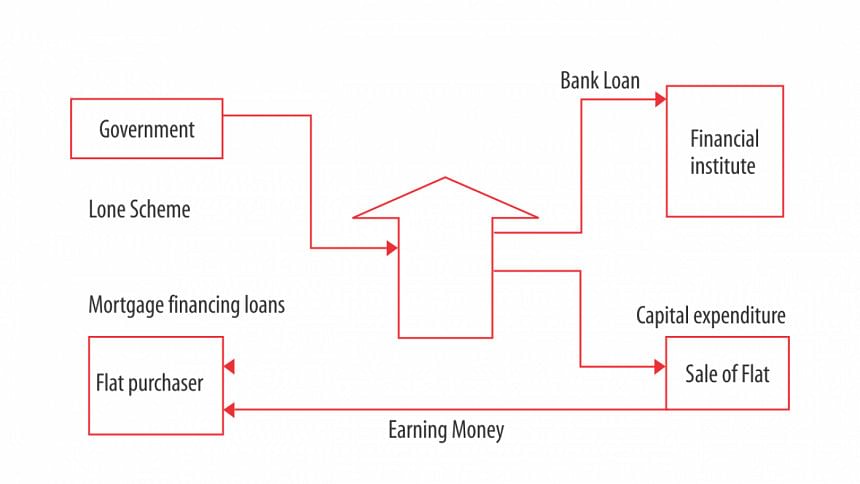Low cost housing in Bangladesh

Housing is a basic need for civilised living. In a developing country like Bangladesh –housing inadequacies and backlog have been increasing mainly due to the galloping increase in population; fast pace of urbanisation and other social and economic factors, which include breaking up of the joint family system, and steep rise in the price of land, building materials and labour. Having a 710 km long coast facing the Bay of Bengal, Bangladesh is frequently prone to natural hazards such as floods, tropical cyclones, tornadoes and tidal bores. Since 75 percent of the households are still living in simple huts or houses made of mud, the consequences of these scourges are all the more disastrous. Many house destructions are noted every year in rural areas due to low quality housing, poor materials and wrong building practices. However, the government, international institutions and private bodies strive to strengthen Bangladesh against these threats.
Therefore, a resistant and decent home to every Bangladeshi household should be offered. The affordable prices and customised mode of payment, corresponds perfectly to the needs of low and middle-income people living in rural areas can be ensured as well.
In the national housing policy, emphasis has been given on 'low cost housing' - a term which has many connotations and needs clarification. As a matter of fact, low cost housing means housing at low cost for all sections of the population. The accent is on housing at lower cost as compared to the prevailing cost levels. The prime objective is to reduce cost and make housing an eco-friendly one. As natural calamities like flood and cyclone are common phenomena in context of Bangladesh, this low cost housing should be durable and should have good living conditions for the dwellers. The focus should not only be on rural areas but also on slum areas in big cities like Dhaka and Chittagong. Thousands of people are living here with inadequate facilities and unhygienic condition. Surely, by low cost housing it is meant to achieve 'cost effective' housing for all, particularly for the low-income families so that - to the extent possible - housing is brought within their reach. But, low cost housing should not mean low quality housing, although the cost and quality go together. The total cost of housing, called 'life cycle cost' of housing, taking into consideration the initial capital cost of housing construction and also the recurring cost of maintenance and repair of housing, over a period of its economic service life, should be determined and the most cost effective housing should be adopted. The availability of land for public housing is very low. In order to house the urban poor, adequate quantities of land must first be made available in order that housing units can be built. This requires forward planning and the earmarking of suitable land. But due to the extreme scarcity of land in Bangladesh, the price of land rises very quickly in the urban areas. So, government should take necessary steps to make proper acquisition of land. To allow the authorities for acquiring land quickly and cheaply for public-housing purposes, various legislations should be passed regulating compulsory land acquisition. Compulsory land acquisition has been the most effective way of obtaining land for public development.

Low cost building components such as ferro-cement channel, water tank, corrugated sheet, hollow brick, pre-fabricated concrete elements can be used during the time of construction to ensure cost effectiveness. The Housing and Building Research Institute (HBRI) are already well renowned for manufacturing these cost effective construction components. Construction costs should be kept down through technological innovation, which includes the increasing use of the metal form concrete framework system and the various projects that have made use of the prefabricated system. The government can also manage and produce its own materials required for construction. Brickworks, tile works, and sand and granite quarries can be set up at a low cost. This ensures adequate supply to meet the needs of the construction industry at reasonable costs. The government can help local and foreign material manufacturers develop suitable new materials for this construction purpose in our own country. Labour will contribute in this occasion and this will eradicate unemployment as well. Government can also manage its own pool of labour, with the setting up of the work brigade which should be established to provide elementary training for workers to become semi-skilled tradesmen in the building industry. Government subsidies for public housing will keep the construction cost and price of housing units well below the market rate. Government should have some commitment to ensure cheaper financing for the poor which will discard land cost from the sale price of apartment. The financial policies can be drawn as below-
Urban-planning strategies in most Third World countries are often at odds with policies to improve the lives and living conditions of the urban poor. The effective adoption of an alternative and effective urban development strategy is only possible with a basic restructuring of the social priorities and financial policies. A firm political commitment to social development is necessary to ensure that the required resources are channelled for the benefit of the underprivileged and the community as a whole. It is also important that sufficient land in suitable locations is allocated for housing the urban poor. Without positive intervention, land for housing the urban poor as well as the rural will become increasingly scarce, as, regardless of economic growth, the urban population in most Third World cities like Dhaka is on the increase. This priority should come before other concerns if resources are limited. The provision of infrastructure and physical shelter can be improved over time as resources become more readily available.
The writer is Senior Research Engineer, Structural Engineering and Construction Division, Housing and Building Research Institute. He can be reached at [email protected]

 For all latest news, follow The Daily Star's Google News channel.
For all latest news, follow The Daily Star's Google News channel. 



Comments